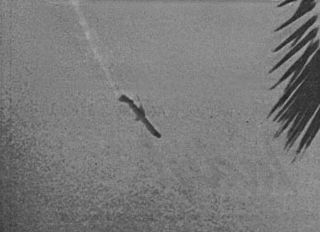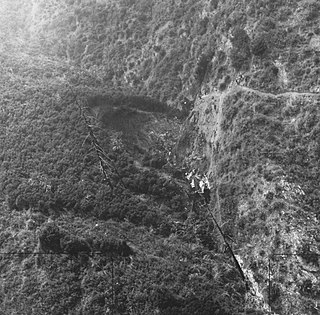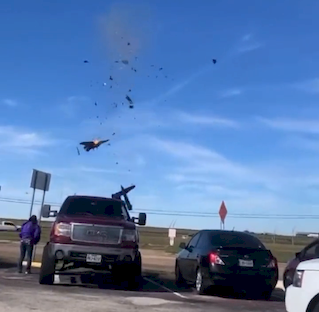
The de Havilland Canada DHC-3 Otter is a single-engined, high-wing, propeller-driven, short take-off and landing (STOL) aircraft developed by de Havilland Canada. It was conceived to be capable of performing the same roles as the earlier and highly successful Beaver, including as a bush plane, but is overall a larger aircraft.

Beginning in the late 1950s the United States aircraft company Bay Aviation produced nine twin-engine conversions of the Beechcraft Bonanza called the Super "V" Bonanza. After production was shifted to Canada in 1962, five more aircraft were built for a total production run of fourteen. The basis of the conversion was the early Model 35 Bonanza with the original small V-tail surfaces. The Super-V competed with Beechcraft's own Travel Air twin-engine Bonanza derivative.

Aeroméxico Flight 498 was a scheduled commercial flight from Mexico City, Mexico, to Los Angeles, California, United States, with several intermediate stops. On Sunday, August 31, 1986, the McDonnell Douglas DC-9 operating the flight was clipped in the tail section by N4891F, a Piper PA-28-181 Cherokee owned by the Kramer family, and crashed into the Los Angeles suburb of Cerritos, killing all 64 on the DC-9, all 3 on the Piper and an additional 15 people on the ground. Eight on the ground also sustained minor injuries. Blame was assessed equally on the Federal Aviation Administration (FAA) and the pilot of the Cherokee. No fault was found with the DC-9 or the actions of its crew.

Monterey Regional Airport is three miles (5 km) southeast of Monterey, in Monterey County, California, United States. It was created in 1936 and was known as the Monterey Peninsula Airport until the board of directors renamed it on September 14, 2011.

New Pacific Airlines, Inc., d.b.a. Ravn Alaska, is an Alaskan airline that specializes in serving small communities in the US state of Alaska. The airline is headquartered in Anchorage, which is also home to its primary hub, Ted Stevens Anchorage International Airport.

Hughes Airwest Flight 706 was a regularly scheduled flight operated by American domestic airline Hughes Airwest from Los Angeles, California to Seattle, Washington, with several intermediate stops. On Sunday, June 6, 1971, the McDonnell Douglas DC-9 serving as Flight 706 departed Los Angeles just after 6 p.m. en route to Seattle as a McDonnell Douglas F-4 Phantom II of the United States Marine Corps was approaching Marine Corps Air Station El Toro near Irvine at the end of a flight from Naval Air Station Fallon in Nevada. The two aircraft collided in midair over the San Gabriel Mountains near Duarte, killing all 49 aboard the DC-9 and the F-4 pilot; the F-4 radar intercept officer ejected and survived.

The Piper PA-12 Super Cruiser is an American three-seat, high wing, single-engine conventional landing gear-equipped light aircraft that was produced by Piper Aircraft between 1946-48. The PA-12 was an upgraded and redesignated Piper J-5.
Taquan Air is the operating name for Venture Travel, LLC, an American regional airline headquartered in Ketchikan, a city in the southeastern portion of the U.S. state of Alaska. It operates domestic scheduled passenger and charter services. Its base is Ketchikan Harbor Seaplane Base, which shares the same harbor and airspace as Ketchikan International Airport. As per the United States Department of Transportation in a report dated August 2, 2010, Taquan Air is a "U.S. Certificated Air Carrier", and is 1 of 125 such carriers in the US.

On August 8, 2009, at 11:53 a.m. (15:53 UTC), nine people died when a tour helicopter and a small private airplane collided over the Hudson River near Frank Sinatra Park in Hoboken, New Jersey, United States. The aircraft were in an area known as the "Hudson River VFR Corridor", which extends from the surface of the river to altitudes of 800 to 1,500 ft at various locations along the Hudson River in the immediate area of New York City. Within this corridor, aircraft operate under visual flight rules (VFR), under which the responsibility to see and avoid other air traffic rests with the individual pilots rather than with the air traffic controller (ATC).

Soldotna Airport is a city-owned, public use airport located one nautical mile (1.85 km) southeast of the central business district of Soldotna, Alaska.

On Thursday, January 15, 1987, SkyWest Airlines Flight 1834, a Swearingen SA-226TC, and a Mooney M20 were involved in a midair collision at 12:52 MST (UTC−7) near Kearns, Utah, a suburb southwest of Salt Lake City. All ten aboard the two aircraft were killed: two pilots and six passengers aboard the METRO II and two aboard the Mooney.

On 7 July 2013, a single-engine de Havilland Canada DHC-3 Otter, operated by air charter company Rediske Air, crashed on take-off at Soldotna Airport, Alaska. The sole crewmember and all nine passengers on board were killed. The crash was attributed to improper loading.

Gary Allan Knopp was an American politician who served in the Alaska House of Representatives from the 30th district as a member of the Republican Party.
Aero Country Airport is a privately owned public airport 4 nautical miles (7.4 km) west of the central business district of McKinney, Texas, United States. The airport has no IATA or ICAO designation.

On 4 August 2018, a de Havilland Canada DHC-2 Beaver aircraft operated by K2 Aviation crashed in poor weather near Denali, Alaska, United States. All five people on board survived the crash, but died before rescuers were able to arrive at the scene. The five people consisted of the pilot and four Polish tourists.

Taquan Air Flight 20 was a regularly scheduled commuter flight operated by Taquan Air from Ketchikan Harbor Seaplane Base to Metlakatla Seaplane Base. On May 20, 2019, the pilot lost control of the de Havilland Canada DHC-2 Beaver floatplane while landing in the harbor at Metlakatla, Alaska, United States. The airplane overturned, destroying the aircraft and killing both persons aboard. The accident was attributed to challenging wind conditions that proved too difficult for the relatively inexperienced pilot to handle.

On May 13, 2019, a de Havilland Canada DHC-2 Beaver floatplane operated by Mountain Air Service collided with a Taquan Air de Havilland Canada DHC-3 Turbine Otter floatplane over George Inlet, Alaska, United States. The DHC-2 broke up in mid-air with the loss of all four passengers and the pilot. The DHC-3 pilot was able to maintain partial control – enough to perform a forced landing on George Inlet – but the aircraft sustained substantial damage in the collision and the landing; the pilot suffered minor injuries, nine passengers suffered serious injuries, and one passenger was killed. Both aircraft were conducting sightseeing flights under visual flight rules, which state that the pilot of each aircraft is responsible for visually ensuring adequate separation from other air traffic, commonly known as "see and avoid".

On November 12, 2022, two World War II–era aircraft, a B-17 Flying Fortress and a Bell P-63 Kingcobra, collided mid-air and crashed during the Wings Over Dallas air show at Dallas Executive Airport in Dallas, Texas, United States. The air show, which coincided with Veterans Day commemorations, was organized by the Commemorative Air Force.
Alaska mid-air collision may refer to:

















